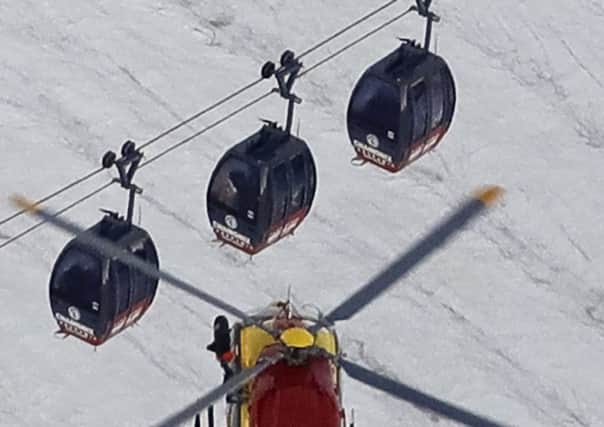Dozens of tourists rescued from French cable cars stuck in Alps


Their return to land ended an extraordinarily complex and vertiginous rescue effort over two days amid the spectacular but dangerous landscape of Western Europe’s tallest mountains.
The last passengers were brought down yesterday morning, after emergency workers managed to untangle cables that had jammed on Thursday, according to the mayor of the French town of Chamonix.
Advertisement
Hide AdAdvertisement
Hide AdWith the cables now straightened, the cable cars were able to resume their journey, at very slow speeds and under close surveillance, and delivered the passengers to the nearest ground stations, mayor Eric Fournier said. The passengers were then flown by helicopter to Chamonix and the Italian town of Courmayeur.
The ordeal began on Thursday afternoon, when cables on the Panoramic Mont Blanc cable car service got twisted, trapping 110 people in a string of cars at 3,800m.
French and Italian helicopters flew in rescuers who dropped down on cables onto the tops of the cars, and lifted out passengers one by one.
“The extent of this rescue operation is simply unbelievable,” said Colonel Frederic Labrunye, commander of the provincial gendarmerie group of Haute-Savoie.
“By the volume of people to rescue – we rarely rescue 110 people at the same time in high mountain – and by the environment in which it happens in the heart of one of the largest glaciers in Europe, over a distance of 5km of cable with 36 cabins.”
Helicopters had to carefully fly over the cables, which is risky itself, then lower a rescuer on to an area “not larger than a table”, strap on passengers one by one and extract them, he said, describing it as “air surgery”.
Then fog descended and darkness started to fall, and authorities called off the helicopter rescue. So they switched to “Plan B,” Mr Fournier said.
Mountain guides identified the cable cars closest to the ground, and used climbing ropes to carry passengers to the surface of the glacier below, one by one. From there, rescuers brought the passengers by foot to the nearest mountain station.
Advertisement
Hide AdAdvertisement
Hide AdFournier said 65 people were rescued overall on Thursday, and another 12 were brought down overnight using “Plan B”.
The remaining 33 people were in cable cars too high off the ground, so they stayed overnight. They included a seven-year-old and nine-year-old from Korea and a ten-year-old Italian child.
“They didn’t get a lot of sleep, but they were warm under blankets and with their families,” Mr Fournier said.
Five rescuers stayed overnight in the cable cars and provided blankets, food and water.